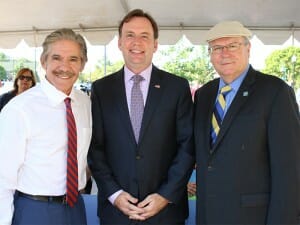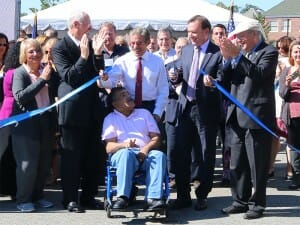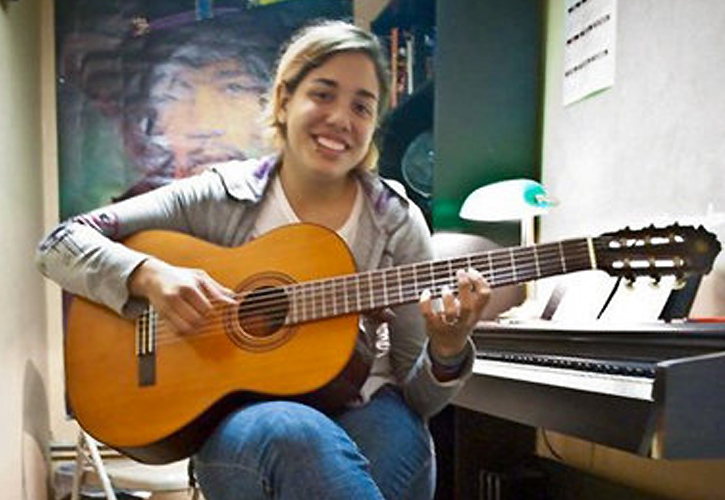
Geraldo Rivera, Michael Cusick, and William J. Fritz joined together for the groundbreaking and launch of the Williowbrook Mile walking and remembrance trail.
STATEN ISLAND ADVANCE – Almost 30 years after the Willowbrook State School for the developmentally disabled closed its doors and released its patients from deplorable conditions, a new pathway at the site of the former facility will unite the sad past with an optimistic future.
Now on the 383 acres that made up the state school is the College of Staten Island, Staten Island Developmental Disabilities Council and the Elizabeth Connelly Resource Center, all of which have collaborated to create the Willowbrook Mile, a path a little more than a mile long that winds through the campus. Ten stations along the pathway have signs with information about the Willowbrook site. They will later include interactive kiosks, some with audio/visual components.
Learn more about The Willowbrook Mile Collaboration [PDF] and the view the Willowbrook Mile Photo Gallery>

Diane Buglioli, Michael Kress, Bernard Carabello, Geraldo Rivera, Michael Cusick, and William J. Fritz cut the ribbon in between Stations 1 and 2 of the Willowbrook Mile.
A groundbreaking took place at the site on Wednesday morning, with TV journalist Geraldo Rivera among the guests to speak about the horrible conditions of the institution that closed in 1987.
While the Advance had written stories in the 1970s about the conditions for children and adults, it wasn’t until Rivera’s expose’ with Eyewitness News that folks off the Island took notice.
View the Willowbrook Mile website>
Rivera met Bernard Carabello, then a young man, while he was living at Willowbrook and remained in touch with him all these years. Both attended the groundbreaking.
[youtube]http://www.youtube.com/watch?v=TahJZ6GpgAk[/youtube]Carabello left the institution at age 21 and now at 66, he is wheelchair-bound and lives an independent life.
“The amazing thing is how normal his life is,” Rivera said, after being in a place for so long that devalued human life and saw it as something to hide away.
Seeing the crowded, unclean conditions in which people lived at Willowbrook “still weighs on my psyche, on my heart,” he said.
“They were warehousing people with disabilities here,” Rivera explained. “They were getting them out of sight … it was concentration camp-like.”
While life “was being squandered” behind the walls of the buildings, now the deinstitutionalization of disabled people allows them to live in their communities with appropriate care.
[youtube]http://www.youtube.com/watch?v=3w7L9kScuLg[/youtube]The path represents celebrating everything that has changed, yet remembering what happened, Rivera said.
Former Willowbrook employee Diane Buglioli was among the several speakers at Wednesday’s groundbreaking.
She is deputy executive director of A Very Special Place, a not-for-profit that provides services to people with intellectual and developmental disabilities, and recalled her first day of work at Willowbrook in 1969.
She was given a heavy steel key that she keeps to this day — she held it up, banged it against the microphone, dropped it on the podium to demonstrate its weight and density.
It was to be used to unlock door after door — heavy, steel doors at the institution.
On her first day, going through all the locked doors, she grew concerned that she might be in jeopardy from whatever lay behind the doors.
“What have I gotten myself into, maybe this was not such a good idea,” she remembers thinking.
Opening up the last door, “I found behind it 40 toddlers,” she said. “Some smiling, some asking me my name, others were silent, just looking at me. Some walked toward me, some were lying in wooden carts and some were sitting on the floor. But they all shared one undeniable truth: they were all little children. To this day, I can still feel the twinge in my stomach thinking to myself, ‘Why are these kids locked behind these doors?'”
“Having seen such injustice, one must ensure it is not repeated,” she said. “No one should be isolated, deprived of care and the tools to thrive and live a productive life simply because they require some assistance to do so.”
At the time, state Sen. John Marchi, Assemblywoman Elizabeth Connelly and Assemblyman Eric Vitaliano championed the closing of the facility, something that Assemblyman Michael Cusick noted on Wednesday.
He secured $125,000 for the project and said, “I wish I could be a third of the legislator those three were.”
Speaking of Connelly, a fierce advocate for the disabled, Cusick said to the stakeholders, “I know that she’s very proud right now of all of you for this project that we are going to start today … she wanted to make sure that the future generations knew exactly what happened here and what is happening presently and in the future. It’s her legacy, I believe, that lives on with a project like this.”
Written by Rachel Shapiro for the Staten Island Advance and published September 14, 2016 on www.silive.com. It is reprinted here with permission.

![[videos, gallery] CSI pathway remembers Willowbrook’s sad past, eyes future](https://csitoday.com/wp-content/uploads/2016/09/Willowbrook-Mile-Featured-Image.jpg)














